|
|
MYSORE
It’s early to see why Mysore, at an altitude of 770 metres, is popularly  with travellers since it’s friendly and easy-going
with plenty of shady trees, well-maintained public buildings, clean
streets and a good climate. The contrasts with the state capital,
Bangalore, couldn’t be greater. Mysore has chosen to retain and promote
its heritage while Bangalore is hell-bent on confronting the 21st
century. with travellers since it’s friendly and easy-going
with plenty of shady trees, well-maintained public buildings, clean
streets and a good climate. The contrasts with the state capital,
Bangalore, couldn’t be greater. Mysore has chosen to retain and promote
its heritage while Bangalore is hell-bent on confronting the 21st
century.
Mysore is also a crafts center, and there are numerous shops
selling a large range of sandalwood, rosewood and teak carvings, and
furniture. Probably the most stunning display can be seen at Cauvery
Handicrafts in the center of town.
Until Independence, Mysore was the seat of the maharajas of Mysore,
a princely state covering about a third of present-day Karnataka, and
their attraction. Just south of the city is Chamundi Hill, topped by an
important Siva temple. North of the city lie the extensive ruins of the
fortress of Srirangapatnam, built by Hyder Ali and Tipu Sultan on an
island in the middle of the Cauvery River. Tipu Sultan fought the last of
his battles with the British here in the closing years of the 18th
century. To the east is the beautiful temple of Somnathpur while to the
west, below the Krishnaraja Sagar (Dam), are the Brindavan Gardens, a
popular attraction with Indian tourists.
National Parks
Accommodation and transport for the national parks of
Bangalore (80 km south of Mysore) or Nagarhole (93 km south-west) should
be booked with the Forest Officer, Woodyard, Ashokpuram (near the
Siddhartha High School in a southern suburb of the city). Take an
auto-rickshaw or a No 61 city bus.
Mysore Palace
Also known as the Amba Vilas Palace, the beautiful
profile of this walled Indo-Saracenic palace, the seat of the maharajas of
Mysore, graces the city’s skyline. An earlier palace burnt down in 1897
and the presence one was completed in 1912.
 Inside it’s kaleidoscope of stained glass, mirrors, gilt and
gaudy colours. Some of it is undoubtedly over the top but there are also
beautiful carved wooden doors and mosaic floors, as well as a whole series
of mediocre, though historically interesting, paintings depicting life in
Mysore during the Edwardian Raj. Note the beautifully carved mahogany
ceilings, solid silver doors, white marble floors and superb columned
Durbar Hall. The palace even has a selection of Hindu Temples within the
palace walls including the Varahaswamy Temple with a gopuram
which set the pattern for the later Sri Chamundeswari Temple on Chamundi
Hill. The former maharaja is still in residence at the back of the palace.
Inside it’s kaleidoscope of stained glass, mirrors, gilt and
gaudy colours. Some of it is undoubtedly over the top but there are also
beautiful carved wooden doors and mosaic floors, as well as a whole series
of mediocre, though historically interesting, paintings depicting life in
Mysore during the Edwardian Raj. Note the beautifully carved mahogany
ceilings, solid silver doors, white marble floors and superb columned
Durbar Hall. The palace even has a selection of Hindu Temples within the
palace walls including the Varahaswamy Temple with a gopuram
which set the pattern for the later Sri Chamundeswari Temple on Chamundi
Hill. The former maharaja is still in residence at the back of the palace.
The main public rooms of the palace are open to the public although
the crowds can sometimes rival the departure lounge of a major
international airport.
On Sunday nights (and on some holidays) 97,000 light bulbs
spectacularly illuminated the palace between 7 and 8 pm.
Chamundi Hill
 Overlooking Mysore from the 1062-metres summit of
Chamundi Hill the Sri Chamundeswari
Temple makes a pleasant half –day excursion. Pilgrims are supposed
to climb the 1000-plus steps to the top but those not needing to improve
their kharma will probably find descending more sensible than ascending!
There is a road as well as the pathway to the top, and riding up then
walking down has the added benefit of avoiding the pilgrim-packed buses
which tend to be more crowded coming down than going up. Overlooking Mysore from the 1062-metres summit of
Chamundi Hill the Sri Chamundeswari
Temple makes a pleasant half –day excursion. Pilgrims are supposed
to climb the 1000-plus steps to the top but those not needing to improve
their kharma will probably find descending more sensible than ascending!
There is a road as well as the pathway to the top, and riding up then
walking down has the added benefit of avoiding the pilgrim-packed buses
which tend to be more crowded coming down than going up.
The temple is dominated by its towering
seven-storey,
40-metres-high gopuram. The goddess Chamundi was the family deity of the
maharaja, and the statue at the car park is of the demon Mahishasura who
was one of Chamundi’s victims. The temple is open from 8 am to noon and
5 to 8 pm.
After visiting the temple start back to the car park and look for
the top of the stairway, marked by red-and –white striped stone posts
and a sign proclaiming ‘Way of Bull’. It’s a pleasant walk down,
there’s some shade on the way and the views over the city and
surrounding countryside are superb. Two-thirds of the way down you come to
the famous Nandi (Siva’s
bull). Standing five metres high and carved out of solid rock in 1659,
it’s one of the largest in India. It’s always garlanded in flowers and
constantly visited by bevies of pilgrims offering prasaad
to the priest in attendance there.
From the bottom of the hill it’s still a couple of km back into
the center of Mysore but there are usually auto-rickshaws waiting to ferry
pedestrians back to town.
Devaraja Fruit
& Vegetable Market
Stretching along Sayaji Rao Rd from Dhanvantri Rd the
Devaraja Market is one of the most colourful in India and provides
excellent subject material for photographers.
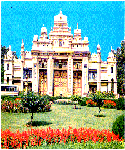 Jaganmohan
Palace & Art Gallery Jaganmohan
Palace & Art Gallery
Just west of Mysore Palace the Jayachamarajendra Art
Gallery in the Jaganmohan Palace has a collection which includes junk and
some weird and wonderful musical machines downstairs, paintings including
work by Raja Ravi Verma upstairs and rare musical instruments on the top
floor. The palace was built in 1861 and served as a royal auditorium.
It’s open daily from 8:30 am to 5 pm.
Railway Museum
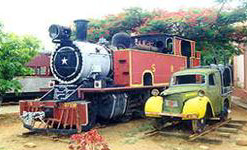
Across the line from the railway station is a small
railway museum with a maharani’s saloon carriage, complete with royal
toilet, dating and around 1888. It’s open daily from 10 am to 1 pm and 2
to 6 pm.
Other
Buildings
Mysore is packed with fine building in a variety of
architectural styles. Dating from 1805 Government
House, formerly the British Residency, is a fine ‘Tuscan Doric’
building, owes nothing to its India setting and still has 20 hectares of
gardens. Facing Government House is Wellington
Lodge where the Duke of Wellington lived after the defeat of Tipu
Sultan.
In front of the north gate of Mysore Palace, a 1920 statue
of Maharaja Chamarajendar Wodeyar stands in the New Status Circle,
facing the 1927 Silver Jubilee
Clocktower. If he glanced sideways he’d see the imposing town hall,
the Rangachariu Memorial Hall
of 1884. The next traffic circle west is the 1950s Krishnaraja
Circle (K R Circle) with a statue of Maharaja Krishnaraja Wodeyar.
Built between 1933 and 1941 in neo-Gothic style St
Philomena’s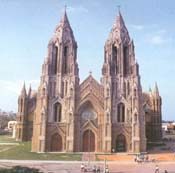 Cathedral, originally St Joseph’s, is one of the
largest churches in India but is not particularly interesting. It stands
north of the center. Converting maharajas’ palaces into hotels is a popular
activity and the Lalitha
Mahal Palace of 1921, on the eastern side of town, is a prime example.
The Metropole Hotel also started life as guest house of the maharajas.
The Rajendra Vilas Palace on
Chamundi Hill, dating from 1938 but actually a copy of an 1822 building,
has been a hotel and there are plans to make it one again. The 1910-11 Chaluvamba
Vilas on Madikeri Rd was another maharaja’s mansion, while the
ornate 1891 Oriental Research Institute in Gordon Park originally housed the
university’s Departmental of Archaeology. Cathedral, originally St Joseph’s, is one of the
largest churches in India but is not particularly interesting. It stands
north of the center. Converting maharajas’ palaces into hotels is a popular
activity and the Lalitha
Mahal Palace of 1921, on the eastern side of town, is a prime example.
The Metropole Hotel also started life as guest house of the maharajas.
The Rajendra Vilas Palace on
Chamundi Hill, dating from 1938 but actually a copy of an 1822 building,
has been a hotel and there are plans to make it one again. The 1910-11 Chaluvamba
Vilas on Madikeri Rd was another maharaja’s mansion, while the
ornate 1891 Oriental Research Institute in Gordon Park originally housed the
university’s Departmental of Archaeology.
Dussehra
Festival
This 10-day festival in the first and second weeks of
October is a wonderful time to visit Mysore. The palace is illuminated
every night and on the last day the maharaja leads on of India’s most
colourful processions. Richly caparisoned elephants, liveried retainers,
cavalry, and the gaudy and flower-bedecked images of deities make their
way through the streets to the sound of jazz and brass bands, and through
the inevitable clouds of incense.
Places to Stay
LALITHA MAHAL PALACE HOTEL, (Government Approved)
Heritage Grand
HOTEL RAMANASHREE, (Government Approved) 3 Star
KAYNES HOTEL, (Government Approved) 3 Star
THE VICEROY, (Government Approved) 3 Star
Things to Buy
Mysore is famous for carved sandalwood, inlay works,
silk saris and incense. The best place to see the whole range is at the
Cauvery Arts & Crafts Emporium on Sayaji Rao Rd. It’s open daily
from 10 am to 1:30 pm and 3 to 7:30 pm. It accepts credit cards, foreign
currency or travellers’ cheque and will arrange packing and export.
Around Mysore
Somnathpur
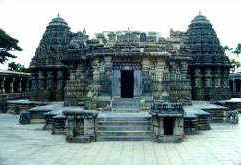 The Sri
Channakeshara Temple stands at the edge of the tranquil village of
Somnathpur, 33 km east of Mysore. Built around 1260 AD during the heyday
of the Hoysala kings, it’s an extremely beautiful and unspoilt building,
although not as large as the other Hoysala temples at Belur and Halebid
north-west of Mysore. Unlike these, though, it is complete. The Sri
Channakeshara Temple stands at the edge of the tranquil village of
Somnathpur, 33 km east of Mysore. Built around 1260 AD during the heyday
of the Hoysala kings, it’s an extremely beautiful and unspoilt building,
although not as large as the other Hoysala temples at Belur and Halebid
north-west of Mysore. Unlike these, though, it is complete.
The walls of the star-shaped temple are literally
covered with superb sculptures in stone depicting various scenes from the Ramayana,
Mahabharata, Bhagavad Gita and the life and times of the Hoysala
Kings. No two friezes are alike-the carved frieze which goes around the
temple has sic strips, starting with elephants at the bottom, followed by
horses, a floral strip, scenes, crocodiles or lions and finally geese.
Srirangapatnam
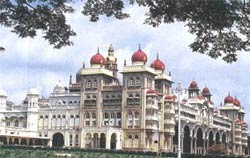
Sixteen km from Mysore on the Bangalore road stand
the ruins of Hyder Ali and Tipu Sultan’s capital from which they ruled
much of southern India during the 18th century. In 1799, the
British, allied with disgruntled local leaders and with the help of a
traitor, finally conquered them. Tipu’s defeat marked the real beginning
of British territorial expansion in southern India.
Srirangapatnam was built on a long island in the Cauvery River.
There isn’t much left of it as the British did a good job of demolishing
the place, but the extensive ramparts
and battlements and some of the gates still stand. The dungeon where
Tipu held a number of British officers has also been preserved. Inside the
fortress walls there’s a mosque and the Sri
Ranganathaswamy Temple, a popular place of pilgrimage for Hindus.
Non-Hindus can go all the way inside except to the inner sanctum, where
there is a black stone image of sleeping Vishnu. The population of the
town inside the fort is about 20,000.
One km east of the fort, across the other side of the main road,
stands the Daria Daulat Bagh (Tipu’s
summer palace), set in well- maintained ornamental gardens. It is now a
museum housing some of Tipu’s belongings as well as many ink-drawing of
him and his family. It also has ‘artists’ impressions’ of the last
battle, drawn by employee of the British East India Company. All around
the internal walls of the ground floor are paintings depicting Tipu’s
campaigns, with the help of French mercenary assistance, against the
British. The gardens are open daily; the museum hours are from 9 am to 5
pm daily.
Two km further is the Gumbaz,
or mausoleum, of Tipu and his father, Hyder Ali. This impressive, cream
building with its onion dome and inlaid doors was built by Tipu for his
father and his family.
Ranganathittoo
Bird Sanctuary
 This sanctuary is on one of three islands in the
Cauvery River, three km upstream from Srirangapatnam. If you’re
interested in birds this is a good place to see storks, ibises, egrets,
darters, spoon bills and cormorants. It can be visited at any time of
year, though it’s best between July and August. Access is by a motorable
road, open all year, and there are boats available. There is no
accommodation. This sanctuary is on one of three islands in the
Cauvery River, three km upstream from Srirangapatnam. If you’re
interested in birds this is a good place to see storks, ibises, egrets,
darters, spoon bills and cormorants. It can be visited at any time of
year, though it’s best between July and August. Access is by a motorable
road, open all year, and there are boats available. There is no
accommodation.
|





